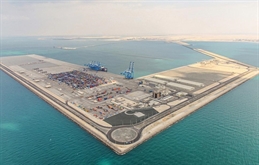
Offshore ports a few miles from the mainland could become the new basis of the US maritime commerce system, making the Suez Canal the main artery for the East Coast from China and hammering the traditional gateways of Los Angeles and Long Beach.
Construction and infrastructure multinational Bechtel has garnered interest from both the private sector and the federal government for setting up the ports. Termed Multi-user Offshore Hubs, they will be able to take 18,000+ teu vessels while also being suitable for bulk cargo. Goods will be transshipped to barges and smaller vessels (probably 10,000 teu) for offloading at the mainland.
A senior executive behind the proposal, Marco Pluijm, ports and marine sector manager for Bechtel, tells Asia Cargo News: “We are currently in initial discussions with several US government agencies about the development of offshore ports along the US coast, primarily for handling containers but with options for dry bulk as well. The most likely locations are the New York/New Jersey/Baltimore area and the Gulf Coast region, with the distance offshore depending on legislation and physical conditions, such as water depth. The current focus is on the technical and financial feasibility.”
The design of the ports will owe much to the Bechtel-managed construction of the US$5 billion deep water Khalifa Port and Khalifa Industrial Zone in Abu Dhabi, which opened in 2012. Khalifa is about 4.5 kilometers offshore, connected to the mainland by a causeway and bridge, with capacity rising from the existing 2 million to 4 million teu. “There are many similarities in terms of port and terminal operations as well as scale, “says Bechtel.
“We have had interest from third-parties including marine contractors, platform operators and terminal operators. Terminal operators in existing ports are also interested in the concept as they will not need to keep on investing in significant upgrades of their existing facilities and make a leap forward and play a major role in the ongoing operations, including providing a short sea shipping or barging link to the offshore port.”
The core of Bechtel’s strategy is huge savings in construction and overland transportation costs. A big advantage in offshore construction is avoiding dredging and associated works, which can account for up to 15% of capital costs. “Shifting containers from overland transport to all-water, directly imported via the Suez Canal could save 20-30% on direct freight costs from the Far East to the US East Coast due to the all-water economy of larger-scale shipping,” says Pluijm.
“We estimate that it could also save between 30 to 40% (or even more) on direct freight costs due to a 40-50% shorter overland transport distance in the US itself,” he says. “And 20-30% lower emissions on the all-water route (lower fuel consumption, more efficient engines) plus 40-50% reduction in overland emissions.”
Bechtel estimates that 70% of all containers offloaded on the West Coast are destined for the interior of the country, while up to 20% (4 million teu) go all the way to the East Coast. The New York/Baltimore hub would have a maximum throughput of 4 million teu a year and the Gulf Coast hub about 3 million teu.
The initial size of each hub will be 1,600 metres long and 300-400 metres wide. “For containers, the offshore hub would consist of a smart terminal arrangement of two or three berths for the main carriers and four or five for barges to nearby ports and coastal shipping, “says Pluijm. “The facilities can be extended in almost any combination with dry bulk, wet bulk and containers, depending on zoning and safety requirements.”
As with Khalifa, automation will be key to operational and financial success. (Khalifa has 30 automated stacking cranes and automated gate control.) “The degree of automation on the offshore terminal is planned to be high in order to minimize the size of the platform, maintaining maximum throughput, while the containers are being shipped to and from the offshore hub to nearby coastal ports or inland-river hubs,” says Pluijm.
Inevitably, this leads to speculation about where the source of recruitment will be for the jobs available. Bechtel is saying nothing about the issue, but many in the industry hope that this could be a way to cut through the control over labour exercised by trade unions at US ports. Non-union, contract staff could be employed without encroaching on the authority of the unions at the mainland ports.
By Martin Rushmere
Correspondent | San Francisco



